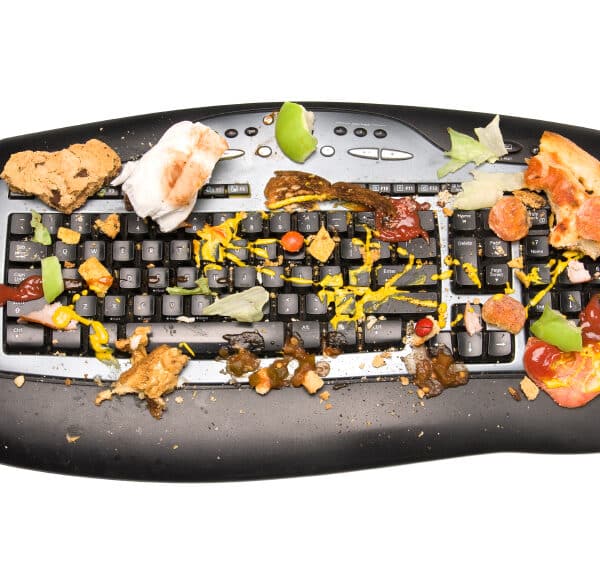
Most work environments have some form of computer technology, including keyboards. Those keyboards may be used by different people throughout the day. There have been many studies worldwide which have demonstrated that keyboards are a source of bacteria, virus and other microscopic pathogens. The prevalent use of computer technology in a work environment must be considered as a potential source for cross-contamination of harmful pathogenic microorganisms which can survive for prolonged periods of time on computer keyboards.
Research based evidence concludes that computer keyboards can potentially spread infections in healthcare settings, where they are used by many people and in communal environments.
Studies
Studies in scientific journals have investigated the links between computer keyboards and nosocomial infections.
- Lu et al. conducted a study in a 1,600-bed medical centre in southern Taiwan with 47 wards and 282 computers. The results revealed a 17.4 per cent (49/282) contamination rate of these computer devices by S. aureus, Acinetobacter spp. or Pseudomonas spp.
- In 2001, Devine et al. cultured MRSA on ward computer terminals in two different hospitals. In hospital A, 12 terminals were cultured and 5 (4 per cent) were positive for MRSA. In hospital B, 13 terminals were swabbed and 1 (8 per cent) were positive for the bacteria.
- In 2000, in a study, Bures et al. cultured a number of microorganisms, including methicillin-resistant Staphylococcus aureus (MRSA), Enterococcus and Enterobacter, from computer keyboards.
- In 1998, Isaacs et al. found two types of antibiotic-resistant bacteria Staphylococcus aureus and Pseudomonas Resistant isolated on the computer terminals when 27 keyboards in a burn unit were swabbed.
These studies show that keyboards can be reservoirs for microorganisms.
Pathogenic microorganisms transfer
Pathogenic Microorganisms can survive for varying periods of time on different surfaces. The vector, which is the individual using the keyboard, can transfer microorganisms from one surface to another.
Most of the accessible components of computers are made of plastic. Studies have shown that microbes live longer on plastics. The hands are the means of transferring the microbes from the plastic keyboard to a service user or other individual.
Risk assessment – infection prevention controls
The management of any work environment should ensure that an infection control policy highlights the equipment used, including keyboards and other computer apparatus. The control measures used to manage the prevention of keyboard-related infection are risk assessed and based on a balance between the amount of risk to the empoyee and service users and the practical element, taking into account the time and cost.
Engineering modifications
Control measures include engineering modifications, such as the use of keyboard covers made of flexible protective film which provide protection against liquids, dust, foreign bodies and other hazardous agents.
Some keyboards have design elements, including a flashing indicator light (symbol) and audible alarm, to prompt users to clean the keyboard at timed intervals, using proper disinfection protocols, to reduce the risk of infections and cross-contamination.
Cleaning and disinfection
Cleaning is the removal of all foreign material, such as dirt and organic material, from an object, while disinfection is a process that eliminates many or all pathogenic microorganisms, with the exception of bacterial spores, from inanimate objects.
- Assess the compatibility of the disinfecting chemical with the computer hardware to be cleaned and disinfected. Use recommended cleaning products for the keyboard.
- Ensure there is a cleaning schedule in place which covers ‘high touch’ items, such as computer equipment within each room.
- Ensure that working with computer equipment is included in policies/procedures for hand hygiene.
- When working with keyboards in high-risk areas, disinfect and wear disposable gloves.
Assess the location of the keyboard
Is it near an area where it can potentially receive droplets of water from hand washing, or droplets from other contaminated sources (sneezing, coughing, vomiting, procedures where blood or pus is present)? Ensure that the keyboard and its associated equipment is not near to sinks or areas in which procedures take place to prevent any splashes.
Information, instruction and training
Providing information, instruction and training to workers will increase their awareness of the principles of prevention of infection, covering keyboards and other computer equipment
Monitoring
A monitoring programme should be in place to ensure infection control guidelines are being implemented and adhered to within the different areas.
QCS infection control policy
QCS provides comprehensive guidance within the infection control policies that can support the business.
References
- Bures S, Fishbain JT, Uyehara CFT, et al. Computer keyboards and faucet handles as reservoirs of nosocomial pathogens in the intensive care unit. Am J Infect Control. 2000;28:465–70.
- Devine J, Cooke RPD, Wright EP. Is methicillin-resistant Staphylococcus aureus (MRSA) contamination of ward-based computer terminals a surrogate marker for nosocomial MRSA transmission and handwashing compliance? J Hosp Infect. 2001;48:72–5
- Isaacs D, Daley A, Dalton D, et al. Swabbing computers in search of nosocomial bacteria. Ped Infect Dis J. 1998;17:533.
- Po-Liang Lu, L. k Siu, Tun-Chieh Chen, Ling Ma, Wen-Gin Chiang, Yen-Hsu Chen, Sheng-Fung Lin and Tyen-Po Chen. Methicillin-resistant Staphylococcus aureus and Acinetobacter baumannii on computer interface surfaces of hospital wards and association with clinical isolates. BMC Infectious Diseases 2009, 9:164
- Ivey JC, Oomen B, Forstall G. Fungal contamination related to personal computer devices installed in a hospital intensive care unit. Am Society for Microbiol Abstrs. 2001; L-1, p 469.
- Neely AN, Maley MP. Survival of enterococci and staphylococci on hospital fabrics and plastic. J Clin Microbiol. 2000;38:724–6.
- Neely AN, Maley MP. Dealing with contaminated computer keyboards and microbial survival. Am J Infect Control 2001;29:131–2.
- Watson SP, Clements MO, Foster SJ. Characterization of the starvation-survival response of Staphylococcus aureus. J Bacteriol. 1998;180:1750–8
Sally Beck RGN, BSc (Hons), MSc, CMIOSH – QCS Expert Health and Safety Contributor



